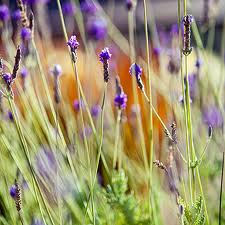Lavandula
|
These perennials are found wild in the Mediterranean region and there are many varieties. Lavender has been used for hundreds of years in sachets, potpourris and linens and to give a light flavor to fruit dishes, sauces, cordials, and confections. The different varieties of this plant range in height from 9 inches to 3 feet, although some may grow taller with age. They have thin leaves and many long spikes of lavender or purple flowers that grow up from the leaf axils. L. angustifolia, English Lavender, is a frost-hardy species that has many pretty cultivars that vary in size, habit and blossom color. L. dentata is a tender species with shorter flower spikes than L. angustifolia. L. stoechas is a large plant with greenish-gray foliage and its late blooming flowers have a very strong scent. L. lanata has whitish colored leaves and L. pinnata has wide leaves. The flowers and the foliage of Lavender are sweet smelling and may be used dried or fresh. They produce fragrant oil that is extracted for commercial use. Hybrids developed specifically for this purpose have a high lavender-oil content and are known as lavandins.
Pot CultivationLavender needs a sunny position in light, well-drained sandy loam. An addition of compost or decayed manure would be beneficial. Add dolomitic limestone to raise the pH to 6.5 to 7.5. Grow tender species and hybrids in containers and bring them into a cool, sunny room during the winter. Fresh Lavender leaves can be used, along with other herbs, to flavor strong game meats and fowl. Use fresh flowers to make Lavender preserves. If desired for dried use, pick flowers just as they open along with some of the scented foliage and hang in a dark, airy room to dry. PropagationThere are a few different methods to increase your plants. Cuttings may be made, which are 3 or 4 inches long, from the new shoots of the season; insert these in sandy soil. Plants may also be divided and replanted. Seeds are very difficult to germinate. Start them indoors in late autumn or winter at a 70- to 75-degree temperature. It is necessary to have fluorescent lights.
Varieties
|





